These nomadic predators are a favorite of ice anglers and delicious on the table
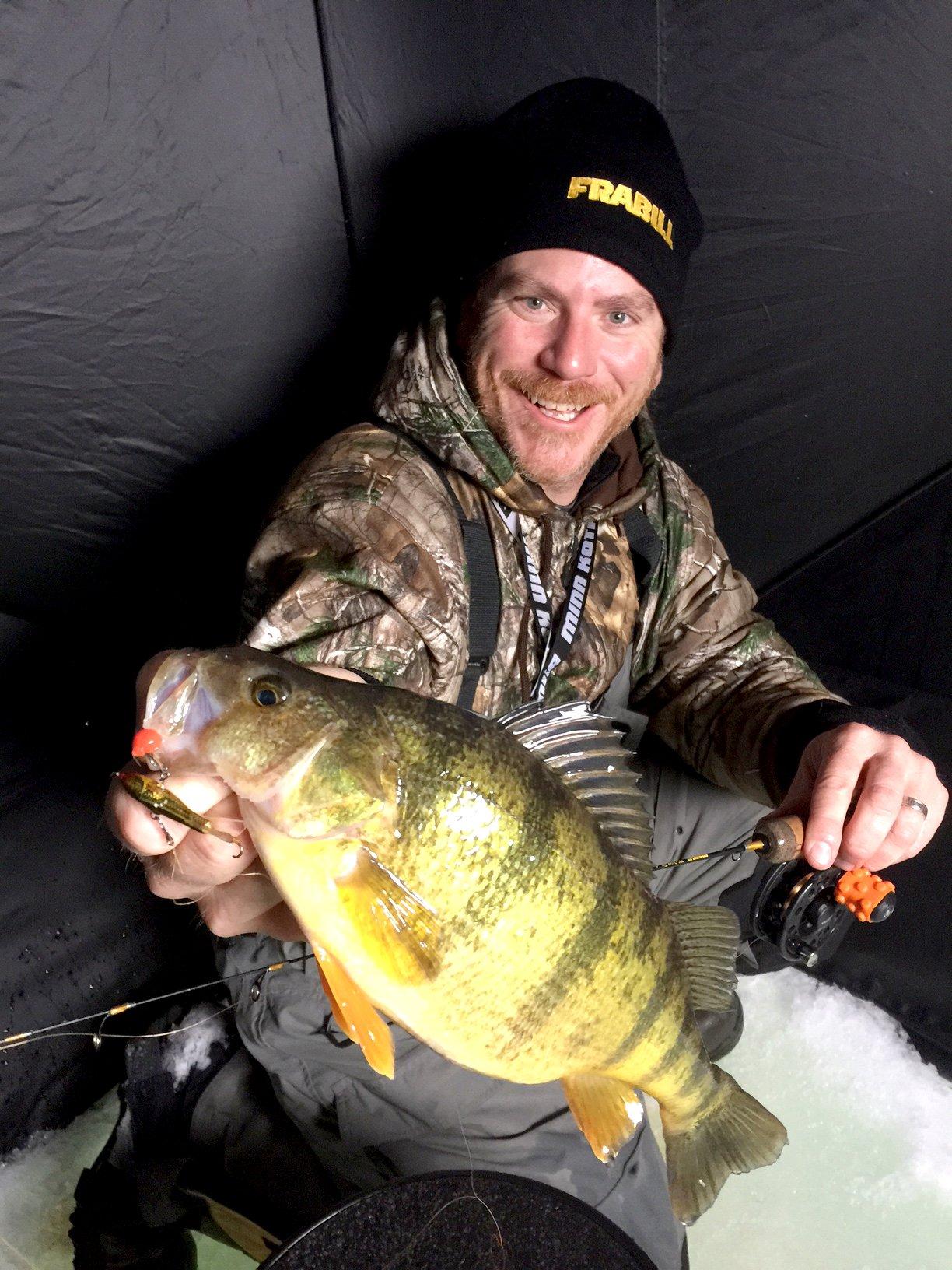
Joe Balog shows off a nice jumbo yellow perch caught through the ice. Photo by Millennium Promotions Inc.
Ice fishing is a misunderstood sport. As seen on Grumpy Old Men, it was once scoffed at as an excuse for northerners to hang out in shanties and drink beer. But today’s ice angling offers a refined approach with frequent bouts of excellent fishing, thanks to advanced equipment.
Good apparel is a leading reason why today’s ice anglers are more effective. Today’s advanced clothing allows anglers to endure the cold without constantly requiring shelter from the elements. We also have better lines and lures, faster augers, and electronics that all but catch the fish for you.
Still, an understanding of fish behavior is the core component to icing more fish. In the case of big yellow perch — often called “jumbos” — a nomadic lifestyle must be considered to stay on top of the fish.
Let’s dig deeper into the variables involved in icing more jumbos.
ALL ABOUT PERCH
Yellow perch are native to nearly all of Canada and most of the northern United States. They’re a cool-water fish (bass, by comparison, are warm-water fish). Fish in the cool category prefer water temps in the 60-degree range. In the case of yellow perch, spawning occurs just after ice-out, as water temperatures crest 40 degrees.
Don’t Miss: The Best Lakes to Catch a 10-Pound Bass This Winter
Their affinity for cool water might be the most important consideration when understanding perch, and it’s one variable many new ice anglers struggle to comprehend. Yellow perch remain very active under ice cover. In fact, these fish are often more active under ice than they are during summer. Besides that, spawning occurs just as the ice leaves the lake, creating a need for heavy foraging as winter loses its grip. Such leads to the “ice-out” blitz beloved by perch anglers.
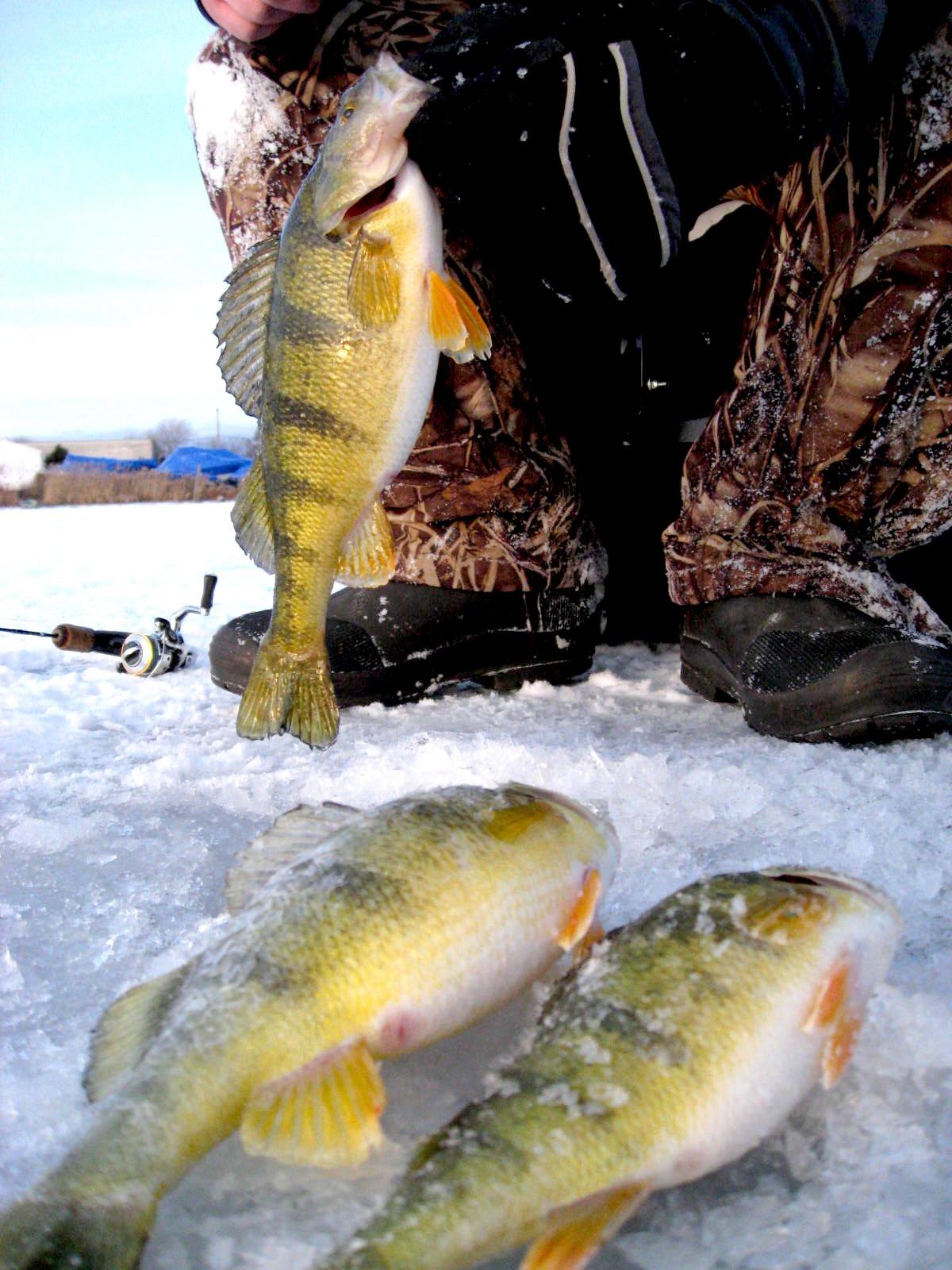
Yellow perch are more active in icy conditions than in the warm summer season. Photo by Millennium Promotions Inc.
Perch are a predatory fish that spend most of their time around prey. This varies though, from small minnows and panfish, to tiny nymphs, crawfish, gobies, and even bloodworms. Perch often move great distances in pursuit of prey and, once they find a source, may continue to travel even as they consume them. Flurries of activity are the result for stationary anglers.
It’s best to understand the forage base on your fishery. If large bays of shallow weed growth are common, chances are those weeds hold the most food, even under ice. Weedbeds will be reduced in winter, but what is left offers outstanding habitat, holding invertebrates and tiny bluegills that big perch love to eat.
In open water areas on massive system like the Great Lakes, perch often feed on roaming baitfish like emerald shiners. Sandy bottoms and clear waters lead to a time-consuming search for jumbos, but can lead to massive hauls once the fish are found.
Deep harbor areas offer unique ecosystems that can contain perch all winter long. Here, forage can be a variety of things, including small gobies. We need to fish accordingly.
START THE AUGER
So, where should you start fishing? In early winter, deep water is usually the key. Remember, “deep” is relative. On shallow, weedy lakes, the outside weed lines are usually most productive, ranging from 8 to 20 feet deep. Again, deep harbors (say 12 feet) are also great on those same systems. For the open water game, begin to look at points leading into deep basins of the lake, perhaps rock or riprap walls with adjacent deep water, bridges; anywhere where the lake’s deep basin combines with structure.
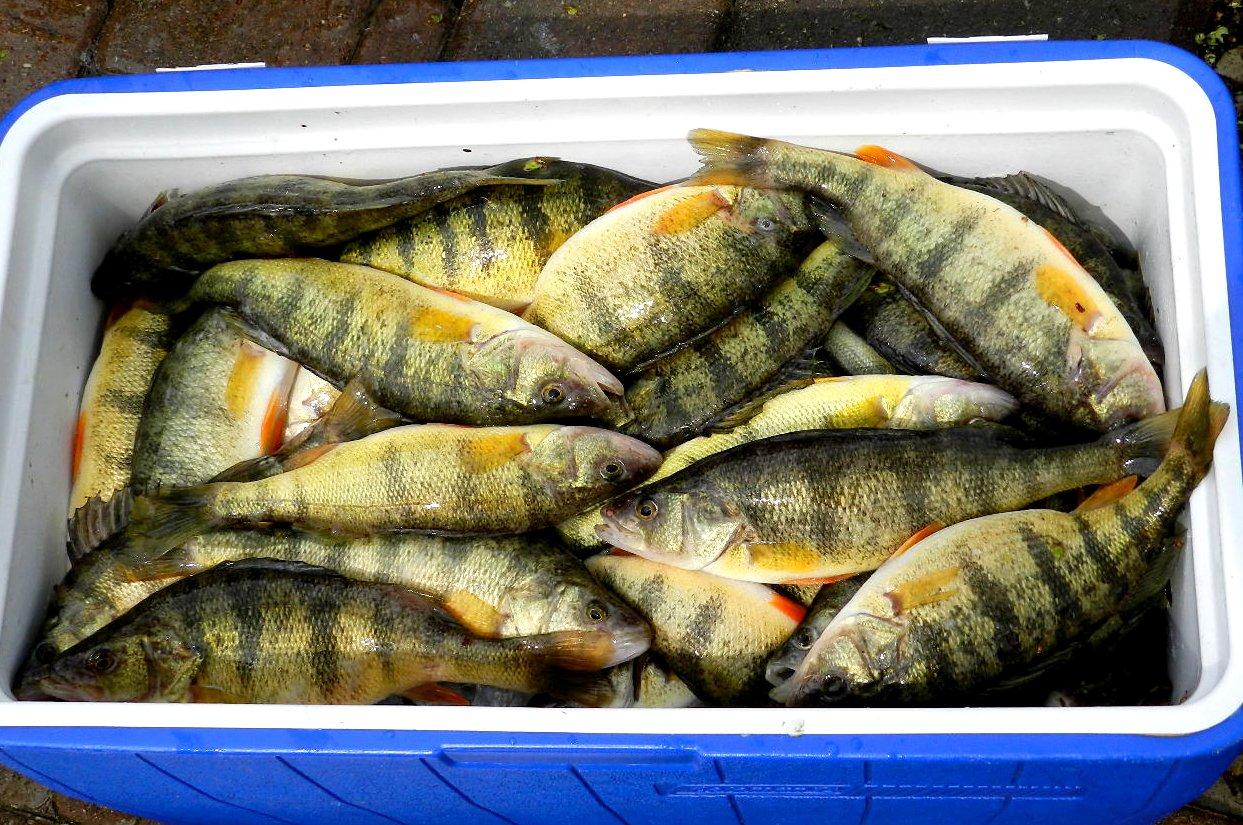
Advanced equipment designed to be used in extreme winter weather helps today’s ice anglers be more successful. Photo by Millennium Promotions Inc.
Perch key on these basin areas in late fall, as forage migrates here when temperatures plummet. Remember, though, if you know of a place that held forage right before the lake iced-up, start your search there, regardless of depth, and work your way deeper
Here, we must touch on electronics. Forward-facing sonar is here to stay, and it has made a tremendous impact on ice fishing. Anglers now can search for fish without ever dropping a bait.
Equally advanced are today’s ice augers. Lithium batteries are powering everything, allowing anglers to pop dozens of holes in no time. Today’s ice fishing is more like open-water angling in that anglers can search for productive areas before ever making a “cast.”
Underwater cameras can be useful for fish identification, especially if the bite seems off. Flashers are still used by many hardcore anglers, too, as the mood of the fish can be gauged instantly once fishing starts. And modern GPS mapping gets us to the best locations instantly, be it on foot or a snowmobile. Some level of these electronic advancements applies to everyone’s fishing.
TACKLE SETUP
With a productive area chosen, it’s time to consider our setup. High-quality ice rods make a big difference. They bend uniformly like open-water sticks, hook and fight fish well, and hold up to lots of hours. Rod length depends on your favorite method of fishing. Inside a portable shanty, seated and close to the hole, it’s best to fish short rods. If open-air is your game, choose rods that allow the tip to be close to the hole while you’re standing. This prevents wind from blowing your line.
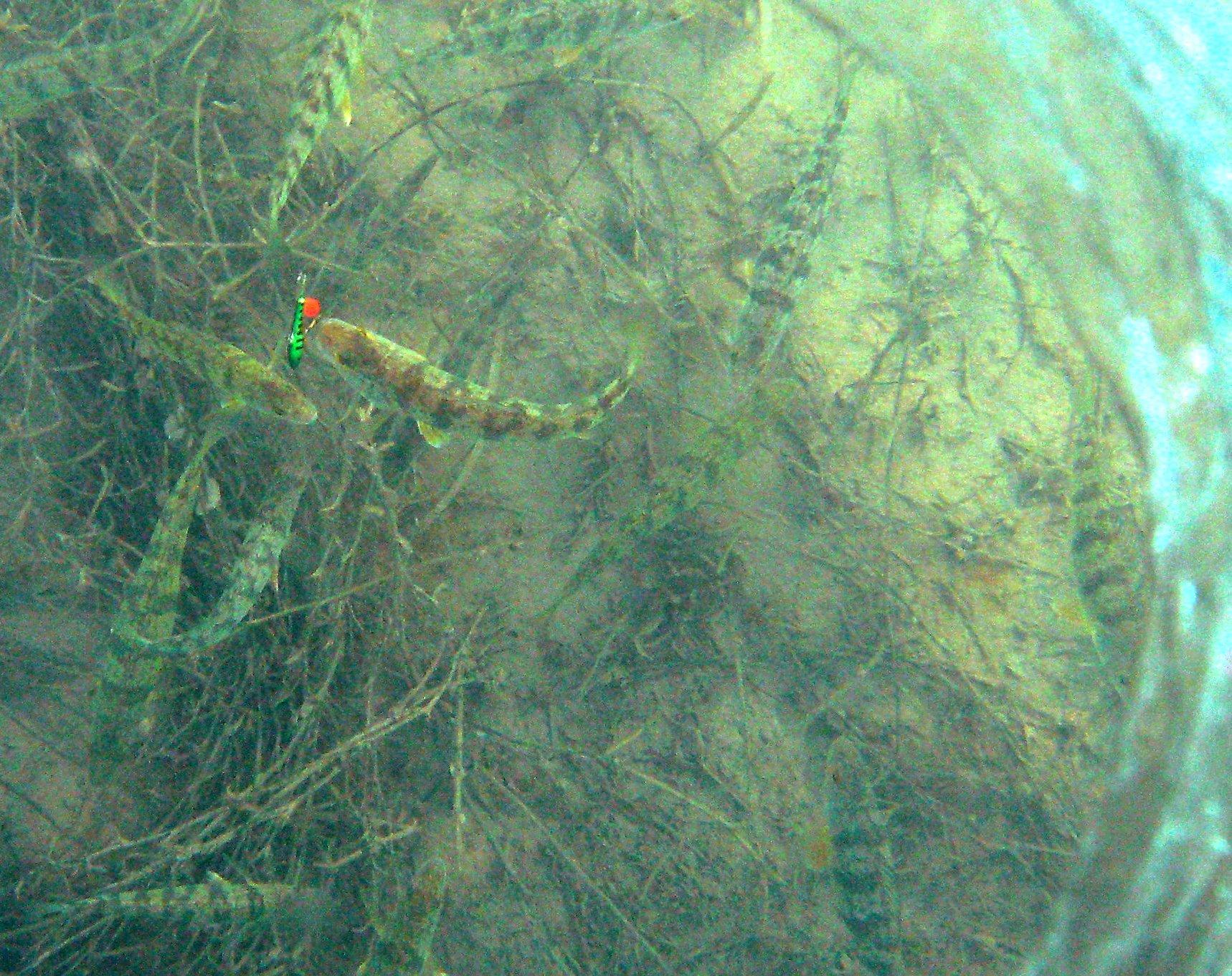
Artificial lures are often as effective as natural bait for catching yellow perch. Photo by Millennium Promotions Inc.
And consider your fishing line type. Micro-braids have a place in ice fishing. Down to sizes like 1/4-pound test, these tiny filaments are strong and impart great action to lures due to their no-stretch characteristics. Braids freeze up worse than other lines, though, since they hold water. That’s not a big concern in a heated shelter, but it could be a deal-breaker outdoors. Two-pound-test mono makes for an all-around workhorse.
Lures or live bait? In the case of yellow perch, artificial baits can keep pace with natural baits, a nice option for anglers who like to run-and-gun. Lure choices fall into a few categories: spoons, jigging lures, and plastics.
Spoons can be traditional jigging spoons, best fished vertically with light snaps and pauses. This proven lure category holds a place across a wide spectrum of species, from walleyes to whitefish. All that really changes is the lure size.
Don’t Miss: All About Muskie Fishing
For perch, tiny spoons in the 1/16-ounce size work best, with a wide-variety of colors available. A red treble hook seems to help the cause. Some anglers tip spoons with natural bait, like a minnow head or maggot, but such a move isn’t needed when fish are actively feeding.
Wobble-spoons expand the category a bit, and they have regional use dependent on model. A cult-like following exists in lower Michigan for lures called “Hard-Beads,” which are diamond-shaped wobbling spoons with a plastic bead impaled on the hook. Perch are attracted to the flash of these sizable spoons, but key on the bead when they bite. It’s an incredibly efficient method for pulling perch form shallow water when they feed on baitfish.
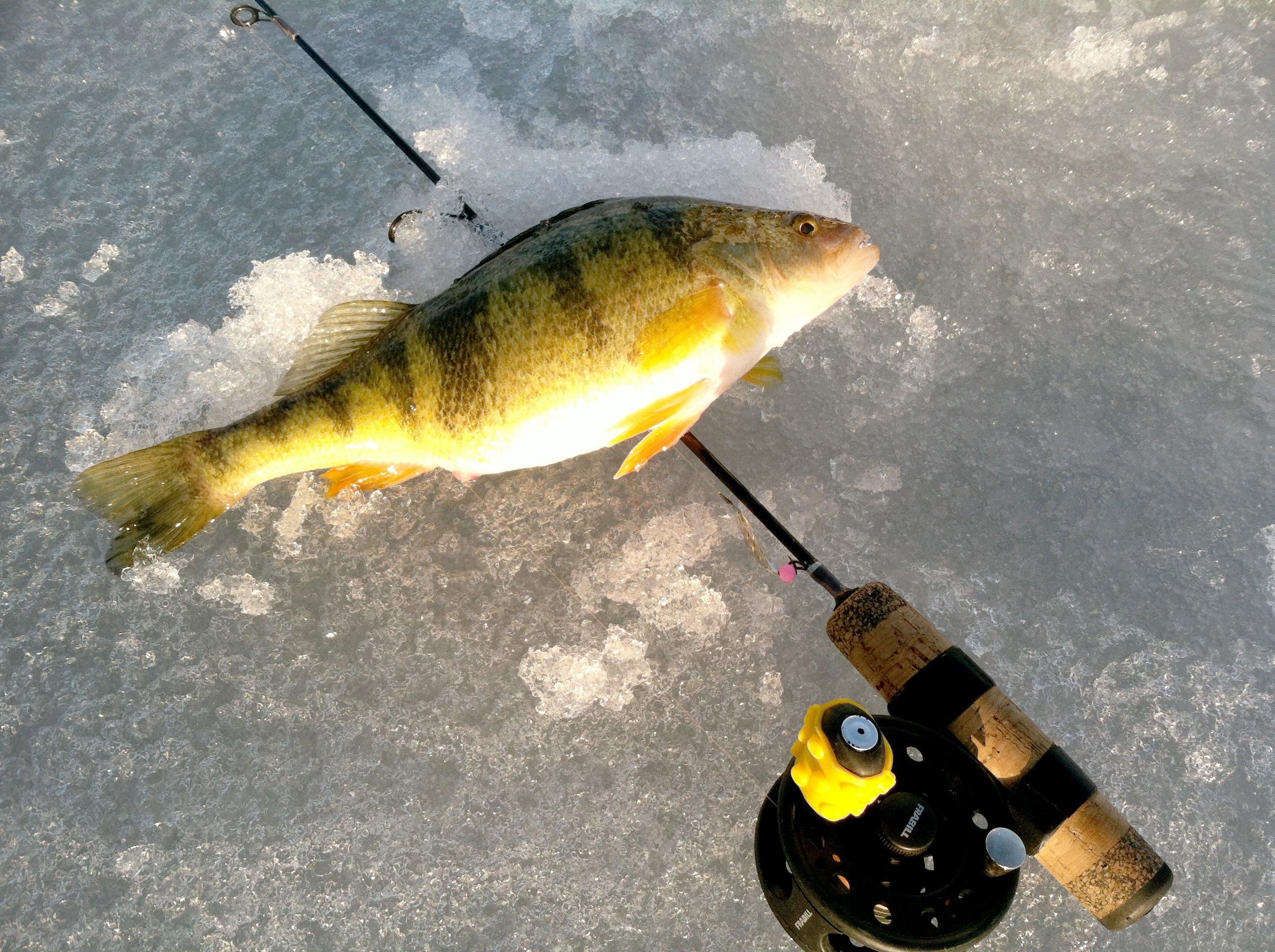
High-quality ice rods are a must for reeling in yellow perch during the winter months. Photo by Millennium Promotions Inc.
Jigging lures make up a category dominated by the original and best, Rapala’s Jigging Rap. These baits fish vertically but swing wide on the jigging stroke. Perch hit on the pause. The lures call fish from long distances, sink fast, and fish efficiently. The smallest two sizes are best for yellow perch. Some folks tip the hook with a live bait or artificial egg. Braided line helps the Jigging Rap really sashay.
Soft plastics have expanded more than any ice fishing lure category in recent times. Advancements in the molding process now allow for micro baits with incredible action. Super-plastics, like Z-Man’s ElaZTech float and quiver, are often unbeatable when combined with a tiny jighead.
Small, 2-inch tubes can be real jumbo slayers, too. Perhaps the tube mimics a goby or small panfish; in any case, a tube lure can often seal the deal when other lures can’t. Fish them on 1/32-ounce jigheads and light mono. Tubes can be especially productive if fish tire of other lures like spoons and jigging baits.
Rotating through several lures may be required to stay in the fish. Often, fast and flashy brings them in and soft plastics do the heavy lifting..
This winter, give jumbo perch a try. They offer a run-and-gun, active ice pursuit and they make excellent table fare. Combine with the challenge of a nomadic nature, and yellow perch may be regarded as America’s best fish under ice.












